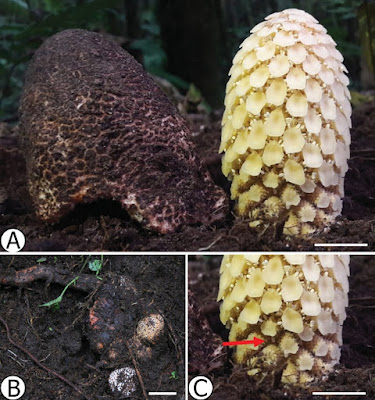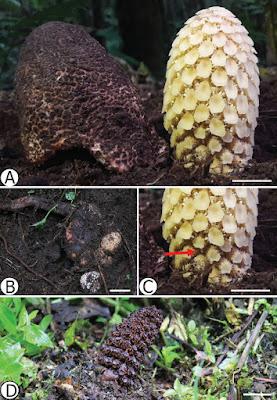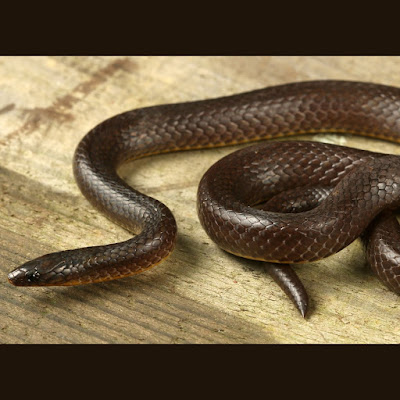[Most Recent Entries] [Calendar View]
Wednesday, November 20th, 2019
| Time | Event | ||||
| 3:56a | [Botany • 2019] Ombrophytum villamariensis (Balanophoraceae) • A New Species of Ombrophytum, A Genus not previously recorded for Colombia
Abstract A new species of Balanophoraceae, Ombrophytum villamariensis Guzmán-Guzmán, is described for Colombia, where the genus has not previously been recorded. At least the first part of the development of the inflorescence is underground. Inflorescences have simple lateral branches, bearing male flowers in the upper part of the inflorescence and female flowers in the lower part. The apical parts (peltas) of the inflorescence branches are morphologically different in the two areas. The first stages of the plants are ball-shaped, within which inflorescences are formed endogenously. When the latter finally emerge, they lift the ball’s surface layer which usually splits, leaving an irregular volva at the base of the inflorescence. Keywords: Eudicots, Balanophoraceae, Caldas, Cordiaceae, Cordillera Central Andina, endogenous inflorescences, Lophophytoideae, parasitic plant, Oxycorynina Ombrophytum villamariensis S. Guzmán-Guzmán, sp. nov. Diagnosis: Ombrophytum villamariensis is similar to O. microlepis of low Amazonian areas of Peru and Brazil. However, differ in a much shorter peduncle (30 mm or absent vs 60 mm), longer male and female inflorescence branches (9–10 mm vs. 3–7 mm and 4–6 mm vs. 4 mm, respectively) and two entirely different types of peltas. Etymology: The epithet refers to the municipality where the new species was discovered, a municipality that stands out for the beauty of its landscapes, its beauty immortalized in its hymn: “…De Colombia, Villa de las flores, y de Caldas bella rosa en botón…” Habitat and distribution: This species is found in Andean forests of the Central Cordillera of Colombia between 2400–2500 m, in the municipality of Villamaria, department of Caldas, Colombia. In addition to the two hosts mentioned above, other genera found at the site were Brunellia Ruiz & Pavón (1794: 71) (Brunelliaceae), Chamaedorea Willdenow (1806: 638) (Arecaceae), Saurauia Willdenow (1801: 407) (Actinidiaceae), Oreopanax Decaisne & Planchon (1854: 107) (Araliaceae), Cyathea Smith (1793: 416) (Cyatheaceae), Juglans Linnaeus (1753: 997) (Juglandaceae) and Croton Linnaeus (1753: 1004) (Euphorbiaceae). Santiago Guzmán-Guzmán. 2019. A New Species of Ombrophytum (Balanophoraceae), A Genus not previously recorded for Colombia. Phytotaxa. 424(1); 61–66. DOI: 10.11646/phytotaxa.424.1.6 | ||||
| 9:24a | [Herpetology • 2019] Trachischium apteii • A New Species of Fossorial Natricid Snakes of the Genus Trachischium Günther, 1858 (Serpentes: Natricidae) from the Himalayas of northeastern India
A new species of natricid snakes, Trachischium apteii sp. nov. is described from the northeastern Indian State of Arunachal Pradesh. The new species differs from its congeners in the following suite of characters: dorsal scales in 15:15:15 rows, SVL 293–299 mm, higher ventral count 143–150, very faint dorsal longitudinal lines, absence of yellow patch on the neck and the belly being pale yellow. Preliminary discussion on the phylogenetic position of the members of the genus Trachischium is presented. This discovery of a new snake species advocates the need for dedicated surveys to document biodiversity across Arunachal Pradesh and the neighbouring States of northeastern India. Keywords: Biodiversity hotspot, Molecular phylogeny, Natricidae, Taxonomy, Species complex
Trachischium apteii sp. nov. Diagnosis: Large-sized member of the genus, reaching SVL of 293–299 mm. Tail comprising of 11–13% of total length. Dorsal scales smooth and glossy, arranged in 15 rows throughout the body. Six supralabials, third and fourth in contact with orbit. Temporals 1 + 1, anterior temporal long. Ventrals 143–150, subcaudals 25–28. Dorsum colouration dark brown to black with faint dorsal longitudinal lines, lacking yellow patch on the neck and the belly being yellowish. ... Etymology: The specific epithet is a patronym, honouring Dr. Deepak Apte, Director of the Bombay Natural History Society, marine biologist and conservationist for his contribution to conservation, and for his continued support to HB and to the Arunachal Expedition, which led to the discovery of the new species. Natural history notes: The holotype, paratype, and another uncollected individual were found under logs during a daytime search. The individuals were likely seeking refuge under the logs during the day. Locals informed the scientific team that the snakes have also been found while digging during non-monsoon seasons. Harshal S. Bhosale, Gaurang G. Gowande and Zeeshan A. Mirza. 2019. A New Species of Fossorial Natricid Snakes of the Genus Trachischium Günther, 1858 (Serpentes: Natricidae) from the Himalayas of northeastern India. Comptes Rendus Biologies. In Press. DOI: 10.1016/j.crvi.2019.10.003 #herpetology #TheArunachalExpedition #newspecies #ArunachalPradesh #northeast #northeastIndia #talleyvalley #talle #singinawaconservationfoundation #nhm #singinawajunglelodge #convservation #biodiversity #research #biology #BBC #natgeo #discovery #animals #snakes #reptiles #media |
| << Previous Day |
2019/11/20 [Calendar] |
Next Day >> |







